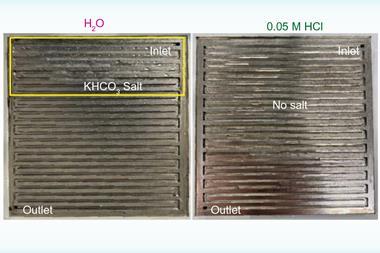Polymers in liquid formulations (PLFs) are a broad group of polymers that are liquid during manufacture or at the point of application. Over 33,000 PLFs are used as ingredients in millions of everyday household products ranging from personal care and cleaning products such as shampoos and detergents, to industrial applications including in agriculture, the automotive sector, construction, lubricants, and in wastewater treatment.
In 2021, the Royal Society of Chemistry convened the Sustainable PLFs Task Force bringing together leaders from different parts of the supply chain and from multiple sectors in the chemicals industries. Its task was to provide leadership and strategy to make the estimated 36 million tonnes of PLFs that are made and sold each year sustainable.
We have been providing regular updates on the progress since the launch of the roadmap, The PLFs Revolution that was featured in our last Voice of the RSC article. Key to the roadmap were two underpinning, timebound missions to catalyse the ambitious transformation to sustainable PLFs by 2040:
Mission 1: Develop and scale biodegradable PLFs by 2030
Mission 2: Advance circular economy infrastructure for PLFs by 2030
Following the launch of the roadmap, we continue to catalyse a varied programme of action across the PLFs ecosystem (from chemical industries, academia and policymakers) to drive the transition forward.

Transitions are never easy. In this article, key industry and academic figures discuss the progress made with the Sustainable PLFs 2040 initiative and highlight the challenges industry are tackling in the transition to sustainable PLFs. Summarising why this is such an exciting but also challenging time for the PLFs sector, Anju Massey-Brooker, RSC programme lead for sustainable PLFs says: ‘There’s an opportunity for industry to be proactive. The chemical industry has made a real impact on decarbonising manufacturing of products via use of greener sources of energy, sustainable water usage, its approach to more sustainable modes of transportation and the use of sustainable materials for packaging. Now is the opportunity to make the right efforts to defossilise the “juice within the bottle” ie the formulation within the outer packaging: for example, your shampoos or detergents inside the plastic bottle. It will be a long journey in which everyone needs to play their part. A PLFs revolution can only drive momentum by bringing together the PLFs ecosystem from industry, research and innovation organisations, policy makers, standards agencies and government offices. This is a call for action.’
Is there enough biomass for PLFs?
This is a key question debated amongst PLFs stakeholders. At present, the building blocks for PLFs are derived primarily from feedstock that is fossil-based. Pivoting from virgin fossil feedstocks to biobased feedstocks will greatly impact industry in terms of the infrastructure, processes and new workforce skills that are required, and will also have environmental implications for biodiversity and future land use.
Ensuring there is resilience in the supply of sustainable non-fossil feedstock is a critical element for successfully de-fossilising the chemical industry and in delivering our 2040 roadmap for sustainable PLFs. Demand for non-fossil derived feedstock for the chemical industry is often seen to be in competition with other sectors such as energy and aviation.
As the product demand increases the cost of these products will come down
Jessica Staniland, research team leader, Croda (personal opinion)
The key question is how to prioritise what we do with the biomass? Biomass is not all the same; there are different risks. For example, growing maize requires a lot of water and can limit biodiversity, whereas planting perennial crops may increase biodiversity. There is a need for better understanding of biomass feedstocks. The challenge is how do we combine different feedstocks to do the activities we want to do?
One of the principles of a circular economy is to keep materials circulating at their ‘highest value’ for as long as possible, and within the tightest loops of the circular economy. Therefore, a balance may need to be struck between durability, repairability, re-manufacturability and recyclability of products.
To successfully harness the full potential of biobased feedstocks across industry sectors, collaboration between government, industry and academia is one of the key requirements needed to develop, demonstrate and reduce the costs of necessary green carbon industrial technologies
Another key challenge for industry is the increased complexity of using biobased feedstock to make new products. A common assumption being if a PLF has been made using bio-feedstock it’s more sustainable than existing fossil based PLFs. Key academic figures involved in the PLFs initiative have commented: ‘We know life cycle analysis data on biobased PLFs sustainability show that sometimes biobased PLFs’ are better and sometimes worse. The outcome can also be dependent on the type of techniques used to test PLFs.’ The chemical industry is actively working to develop and implement standardisation of life-cycle analysis for chemicals to address this challenge.
PLFs are high value speciality chemicals, although only approximately, 36 million tonnes of PLFs are produced each year they make up 22% (US$1.27 trillion) of the global chemicals market.1,2 The breadth and scale of the PLFs market makes PLFs an ideal small-scale demonstrator to trial innovative approaches for the transition to sustainable chemicals. Our Sustainable PLFs 2040 initiative has already gained large momentum across the ecosystem and is delivering consistent steps towards the transition. Indeed, the UK has a unique opportunity to become a world leader in driving the PLFs transition with several of the biggest industry players running their major R&D and manufacturing operations from the UK.
Should the consumer pay the additional costs with new biodegradable/sustainable products?
Jessica Staniland, research team leader at Croda, expressed in her own personal opinion (and not representing the view of Croda): ‘Yes, as it stands today, if the consumer demands and wants sustainable, biodegradable products they will need to pay – and as the product demand increases the cost of these products will come down.’
Further work will be required to bridge the gap between the high cost-efficiency achieved by the chemical industry over a long period of time using fossil fuels to produce consumer products when transitioning to a bio-based supply chain. The economic implications of changing oil prices and the cost of petrochemicals will also need to be considered. This question brings into focus the need for industry to consider new business models for products containing sustainable PLFs.
How do we use the PLFs of tomorrow to formulate the products of tomorrow?
The production processes used to manufacture PLFs have a huge bearing on their impact, both in products and in the wider world. We must predict how to match the performance of best-in-class existing PLFs and test for new behaviours.
Caroline Kelly, head of technology strategy, formulation, at CPI stated ‘There can be typically 10–20 other ingredients in a formulated product. The challenge is that alternative non-fossil based PLFs are unlikely to be direct drop-ins to existing formulations as a result of the complex interactions between the polymers, surfactants and other components, meaning performance and stability are likely to be impacted. And if we think about biodegradable PLFs, there is a challenge in keeping these stable until the point of use. This means there is potentially a huge re-formulation effort required even to make the equivalent products we have today.’
Digital tools and technologies can really help to accelerate formulation R&D
Caroline Kelly, head of technology strategy, formulation, CPI
Foundational formulation science, such as colloid science and advanced characterisation, will be critical in helping tackle this challenge by understanding the effects of structural changes at the molecular level on the PLFs function. The challenge for industry is to be able to reformulate quickly and efficiently as new PLFs are developed.
Kelly commented: ‘The use of digital tools and technologies can really help to accelerate formulation R&D over what we can do with an empirical trial and error approach. Using formulation robotics provides the ability to make and test a large number of trial formulations, but beyond this machine learning-driven adaptive experimental design tools can be used to build statistical models which can then predict formulation performance based on molecular structure and ingredient composition. Such approaches are key to developing new formulations using ‘sustainable’ PLFs.’
The use of high throughput experimentation together with digital tools and technologies such as machine learning, artificial intelligence and automated experimentation to generate large datasets will be essential to help develop new product formulation with biobased PLFs. These digital tools will provide a platform to create multiple formulation compositions and rapidly generate predictive models to understand and exploit the relationship between the formulation ingredients, processing steps and resulting properties of the final formulation. However, having these capabilities in place also creates the need to integrate testing capability for long term product stability and rapid predictive degradation testing under set end of life conditions.
How important are biodegradable PLFs?
As the global population grows, the demand for PLFs will also increase. The Organisation for Economic Co-operation and Development (OECD) stated that the global consumption of materials will double by 2050 and annual waste generation will increase by 70%.3 PLFs present a technically complex challenge as the fate of materials in the environment differs by product range and disposal behaviours. For example, paints and coatings will differ from crop protection or personal care, meaning sustainable fate cannot be a one size fits all solution.
Andrew Dove, Professor of sustainable polymers at University of Birmingham said: ‘If we can capture and circularise PLFs then we don’t need to talk about biodegradation. The key challenge is the huge amount of PLFs that go down our drains that can’t be easily captured.’
The Sustainable PLFs Task Force created the two missions – circularity and biodegradability – to both increase the capture of PLFs that go down the drain and reduce the persistence of those that cannot be caught by the advances in circular economy infrastructure possible by 2030.
Understanding how [PLFs] degrade … is a real challenge for industry
Andrew Dove, Professor of sustainable polymers, University of Birmingham
It is pertinent that circular economy principles are integrated into non-fossil feedstock strategies including increasing formulation efficacy, reducing the non-essential usage of polymers, reformulating away from specific polymers with a large carbon footprint and incorporating recycled secondary materials into production where possible.
New regulation challenges driving biobased and biodegradable PLFs innovation
A key driver for industry’s transition to biodegradable PLFs is new EU regulation being introduced from 2027 by EU REACH, requiring regulation of polymer ingredients contained in formulations that are not biodegradable (excluding degradable or water-soluble polymers and natural polymers that have not been chemically modified). There will be an impact for UK businesses trading in the European market if they are not able to meet these standards and prove their products containing PLFs are biodegradable in this short timeframe. Adding to this pressure is the limited capability in the UK for testing PLFs biodegradation.
Dove also raised the question of the suitability of the current OECD biodegradability water-based tests for polymers in determining biodegradability of PLFs: ‘Are they the most accurate tests for PLFs? Given that there are lots of different formulations containing PLFs, understanding how they degrade when they go into foul water and the way they impact the environment is a real challenge for industry.’
The key challenge is to ensure the next generation of PLFs are benign by design, with biodegradability or circularity built into the architecture of the polymers when considering the product’s post-consumer use stage.
What is the role of policy and regulation in a successful transition?
Momentum in the chemical industry to tackle sustainability challenges and to innovate for a transition to sustainable chemical solutions and practices is being driven by more stringent regulatory environments. Policy, regulation and standards play a powerful role in catalysing and supporting innovation as well as facilitating industry to overcome hurdles such as the scaling up of innovation. The RSC’s recent report The case for a UK Chemicals Agency provides an overview of the barriers businesses currently face in the UK.
This challenge requires ‘triple helix’ innovation – industry, academia, government
Caroline Kelly, head of technology strategy, formulation, CPI
An industry-wide transition requires a diverse and considered approach to maximise long term benefits. The nine planetary boundaries is an important concept defining environmental processes needed to regulate the stability and resilience of the Earth system to continue to support humanity, breaching these boundaries will cause irreversible environmental change. (PLFs directly impact the ’novel entities’ boundary contributing to chemical waste, a threshold that has already been transgressed). For a successful industry transition, it must have in place guiding principles, policy and regulatory frameworks, infrastructure developments, science-based targets and monitoring mechanisms that must cover all aspects of sustainability across the nine planetary boundaries. Mapping the consequences of the transition will help stakeholders to assess impacts on the industry value chain, as will testing shared models and governance frameworks.
Thinking big is crucial to a successful transition
Kelly emphasised that large scale collaboration is essential to support innovation: ‘This is such a big challenge that no single organisation can address it on their own. It requires “triple helix” innovation – industry, academia, government. It goes beyond the standard principles of open innovation and calls for this ecosystem to take a systems approach to define, discover, co-develop and diffuse innovation across the supply chain and needs to bridge industry, academia, environment and policy. We have all the component parts in the UK, what we are missing is the required funding to bring this all together!”
Tackling innovation challenges at a systems level rather than firm level will require finances, scientific consensus, innovation frameworks as well as policy and regulation readiness to support this transition.
Next steps
The RSC will be holding the first Sustainable PLFs Annual Summit event in October in London to share progress made towards our roadmap’s ambition and discuss key challenges and barriers still to be addressed. The event will provide inspiration and galvanise further action and new collaborations to ensure that, together, the industry-wide transition to sustainable PLFs is realised for 2040.
If you are interested in hearing about the outcomes of the Annual Summit, please contact Kate Carlisle, programme manager for sustainable polymers at the Royal Society of Chemistry plfs@rsc.org
References
1. The PLFs Revolution Our 2040 roadmap for sustainable polymers in liquid formulations. Royal Society of Chemistry July 2021
2. Chemical industry worldwide – statistics & facts (global). Statista Research Department, Feb 27, 2024. Chemical industry worldwide - statistics & facts | Statista
3. Global Material Resource Outlook to 2060: Economic Drivers and Environmental Consequences OECD Publishing, Paris 2019 http://doi.org/10.1787/9789264307452-en



















No comments yet